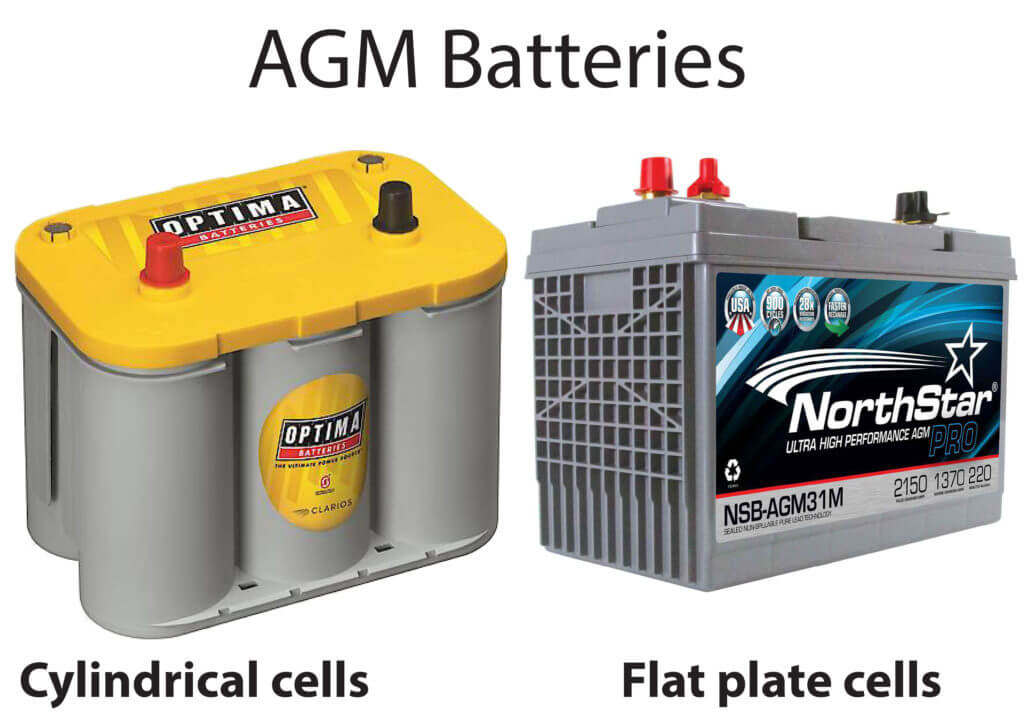Here’s what makes an AGM battery so desirable
The Many Advantages of AGM Batteries Compared to a standard flooded battery
AGM stands for an absorbed glass mat or absorbent glass mat. An AGM battery has positive and negative plates and separators just like regular flooded lead-acid batteries, but they have an absorbent glass mat between the plates that absorbs and holds the liquid electrolyte. Think of the glass mat like a sponge that holds the electrolyte. Because the electrolyte is held so close to the plates, the battery offers distinct advantages over an standard lighting ignition (SLI) battery.
Here are the advantages of an AGM battery over an SLI battery
• It has more cold cranking amps to deliver a more powerful burst of power for starting the engine — up to 35% more cranking power than an SLI battery.
• It has a higher reserve power rating so it can run the vehicle’s electronics for longer periods when the engine isn’t running.
• It’s designed to handle deeper discharge cycles and recover faster than an SLI battery, making it better suited for start/stop systems.
• It lasts longer than an SLI battery
How does it do that?
• An AGM battery has a lower internal resistance so it can create more power. The glass mat and tight packing allows for easier electron flow during power demands and recharging. In addition, the internal plate chemistry and bus bars provide lower internal resistance which translates into more power from a smaller battery. In many cases, an AGM car battery will be smaller and deliver more power than a comparable flooded lead-acid SLI battery.
• They have a lower self-discharge rate. All lead-acid batteries self-discharge over time. But AGM batteries have a lower self-discharge rate than SLI batteries, so you can leave them longer without starting the vehicle, and stores can leave them on the shelf longer without having to charge them.
• It’s more resistant to sulfation and degradation. All car batteries are susceptible to sulfation, but AGM batteries don’t sulfate as easily as flooded SLI batteries. What causes battery sulfation?
• They lose less electrolyte. AGM batteries have an internal valve that regulates how much hydrogen gas is allowed to escape during charging. Batteries with these valves are referred to as valve-regulated, lead-acid batteries (VRLA). By limiting the amount of hydrogen and H2o lost, AGM batteries are more maintenance-free. You do not have to add water to an uit.
• They recharge faster than a flooded lead-acid battery. Due to their lower internal resistance, an AGM battery rechargse faster and at a lower voltage, which lowers the heat, which extends battery life. In fact, it accepts a charge up to five times faster than a comparably sized SLI battery.
• It’s more resistant to vibration. Because they don’t have battery acid sloshing around and because the cells are tightly packed, they don’t shed as much plate material as SLI batteries.
AGM battery construction differences compared to a flooded battery
An AGM battery contains positive and negative plates like a flooded lead-acid battery. But glass mat separators replace the standard plastic separators. The glass mats absorb and hold the electrolyte close to the plates. Plus each cell is tightly packed so there’s optimal contact between the electrolyte and the plates. The high pack pressure reduces internal resistance, reduces plate shedding, and thus increases battery life.
Since they off-gasses less than a typical flooded lead-acid battery, they don’t have vent caps. Instead, it is referred to as a fully recombinant battery, which means it converts a larger portion of the gasses back into the electrolyte.
However, they do contain a valve regulated vent that opens when the internal pressure reaches approximately 3-7-psi. This pressure build occurs when an it is charged at too high a voltage or too high a current. The vent valve is a one-way check valve, so overcharging an AGM style battery can cause permanent loss of electrolyte.
They are NOT gel cells
Many people refer to cylindrical spiral-wound AGM batteries as gel cells. They are not. Gel cell batteries are never used in the automotive industry for starting applications.
Not all have cylindrical cells
AGM batteries can be made with flat plate technology or wound cylindrical cells.

Cylindrical cell versus flat plate technology
©, 2020 Rick Muscoplat
Posted on by Rick Muscoplat
